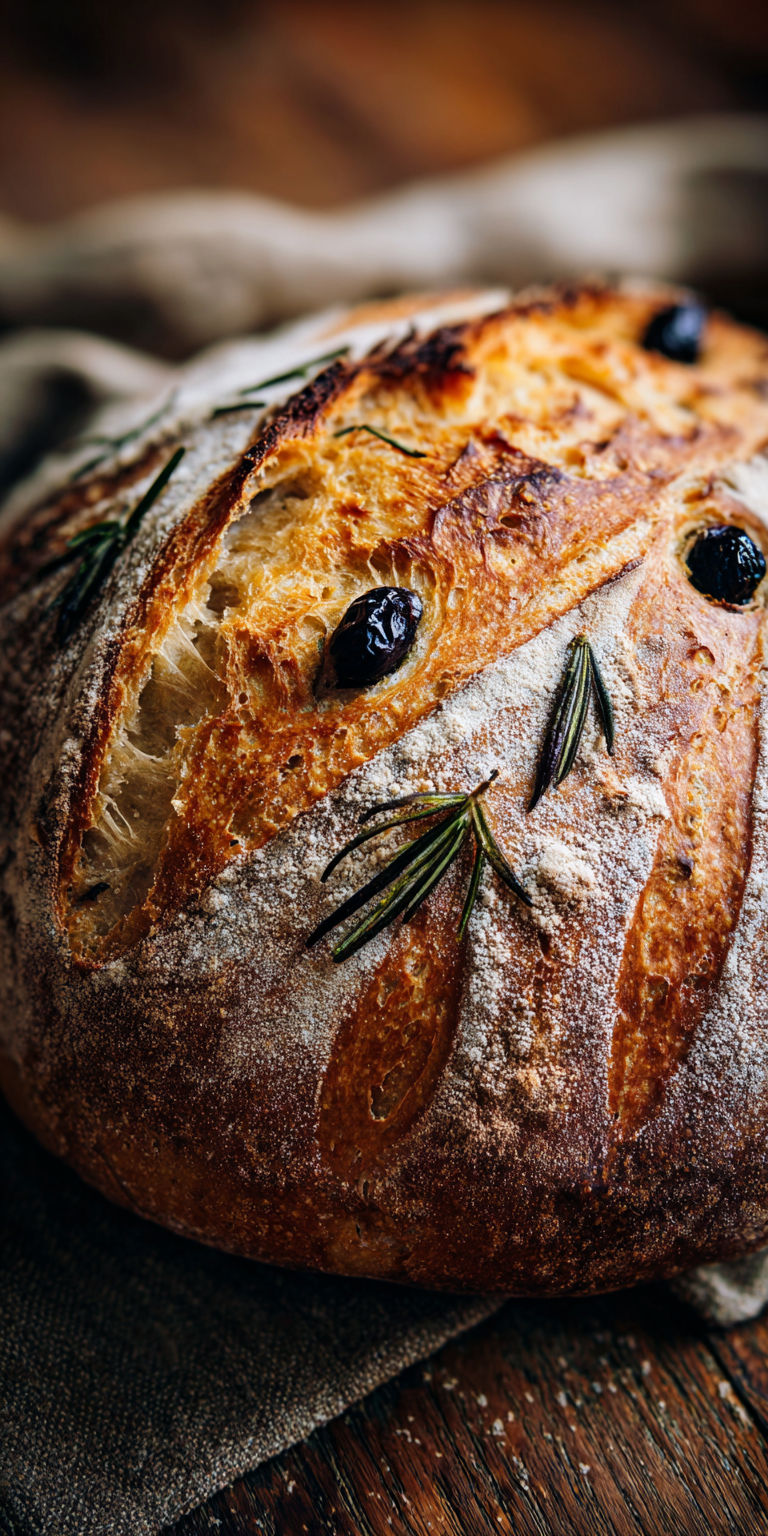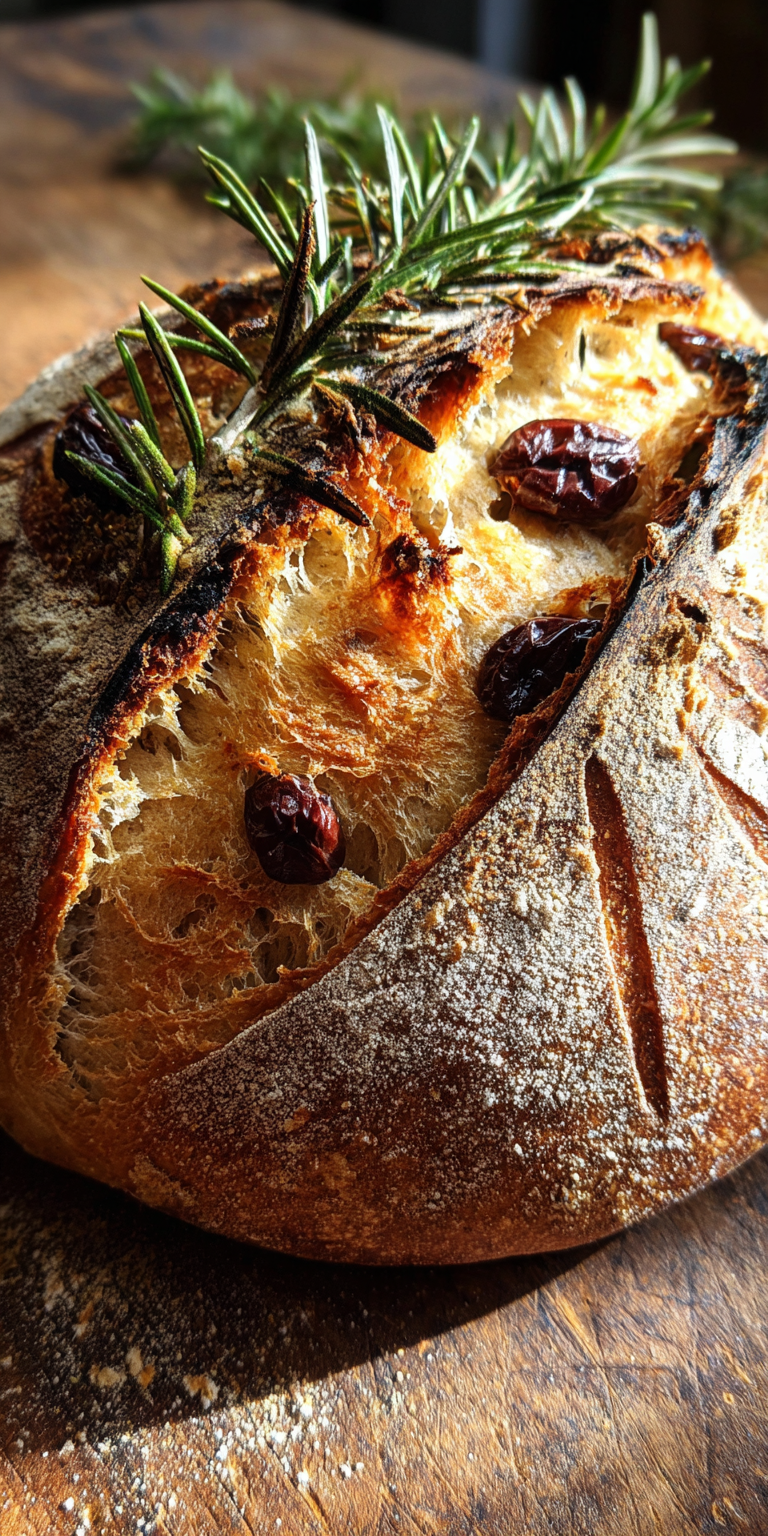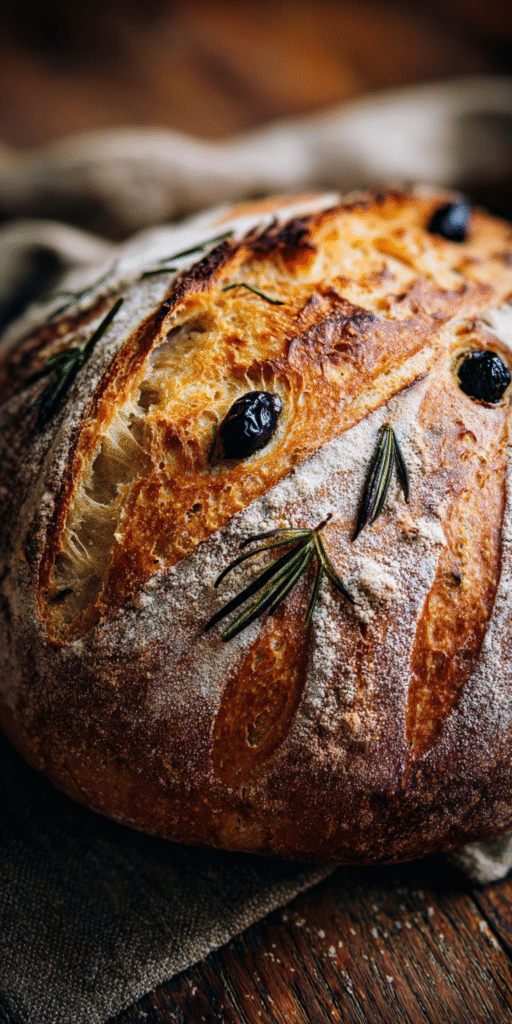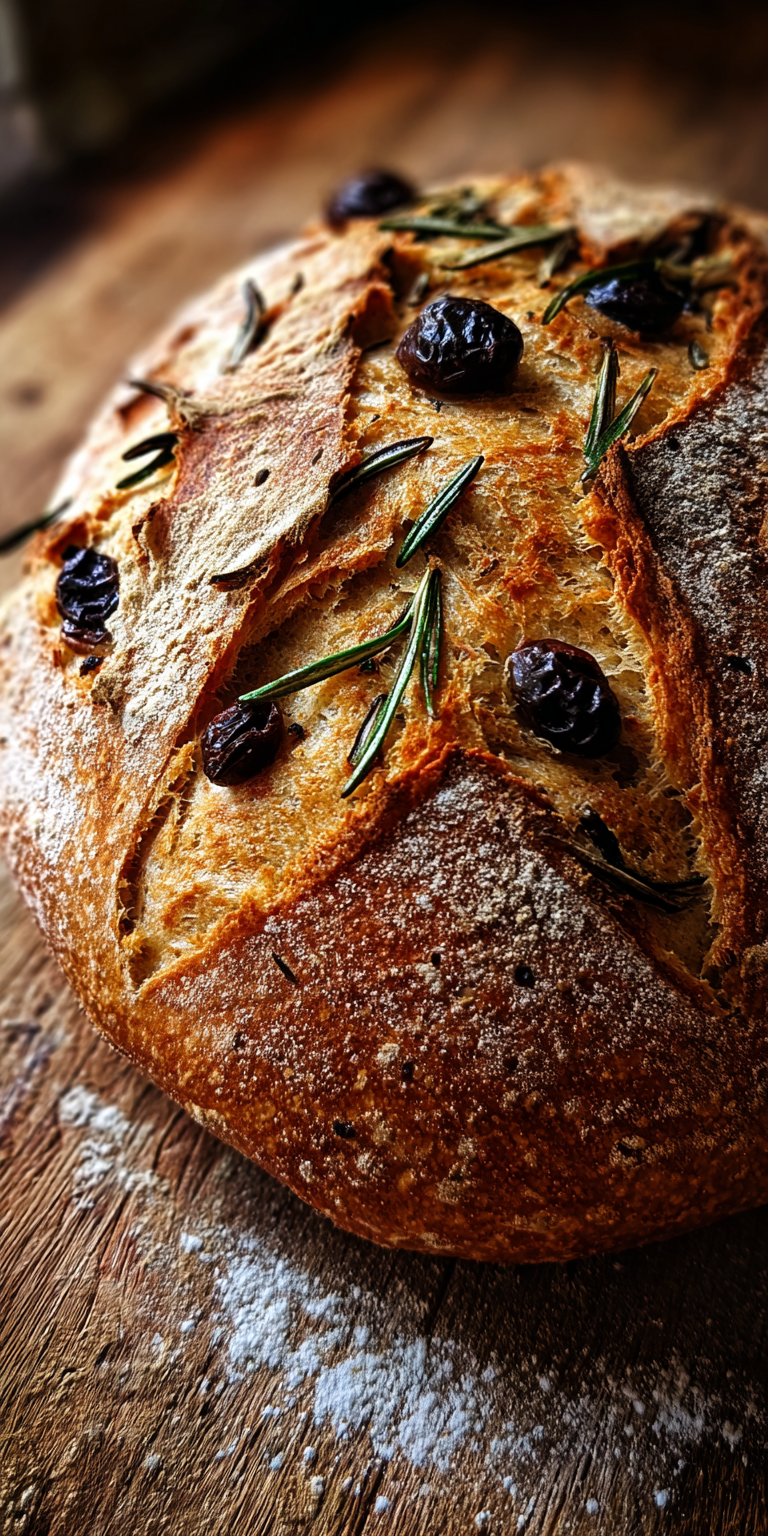There’s something truly magical about baking a loaf of Rosemary Olive Country Sourdough at home. The aroma of fresh rosemary, the tangy bite of olives, and the chewy, crusty texture of sourdough combine to create a bread that feels straight out of a rustic European boulangerie. This recipe brings the charm of artisan bread into your kitchen, making it perfect for both novice bakers and seasoned bread enthusiasts looking to elevate their homemade bread recipes easy collection.

Beyond its incredible flavor, this sourdough is a labor of love that connects you to the ancient art of bread-making. Using a sourdough starter recipe, you’ll craft a loaf that’s not only delicious but also packed with natural fermentation benefits. Whether you’re pairing it with a hearty soup or enjoying it with a drizzle of olive oil, this bread will quickly become a staple in your home.
In this guide, I’ll walk you through every step to create your own masterpiece. From mixing the dough to achieving that perfect golden crust, you’ll find all the tips and tricks for success with bread recipes homemade. Let’s dive into the world of rustic baking and create something extraordinary!
Recipe Overview
- Cuisine: European / Rustic
- Category: Artisan Bread
- Prep Time: 30 minutes (plus fermentation time)
- Cook Time: 45 minutes
- Total Time: About 18–24 hours (including fermentation)
- Servings: 8–10 slices (1 loaf)
What You’ll Need
Creating a flavorful Rosemary Olive Country Sourdough requires a handful of simple yet purposeful ingredients. Each component plays a vital role in achieving the perfect texture, taste, and crust that defines artisan bread recipes. Here’s a breakdown of what you’ll need and why each element matters:
- Sourdough Starter: This is the heart of any sourdough recipe, providing natural fermentation for a tangy flavor and airy texture. Make sure your starter is active and bubbly before beginning.
- Flour: A mix of bread flour and whole wheat flour gives structure and a rustic depth to the loaf, mimicking traditional boulangerie styles.
- Water: Hydration is key to a chewy crumb; use lukewarm water to help activate the starter.
- Salt: Enhances flavor and strengthens the dough’s gluten network for better structure.
- Rosemary: Fresh or dried, this herb infuses the bread with an earthy, aromatic note that pairs beautifully with olives.
- Olives: Kalamata or black olives add a briny, savory punch that elevates this loaf into something truly special.

Gather fresh rosemary and olives for a rustic sourdough loaf
INGREDIENTS
- – 1/2 cup active sourdough starter
- – 3 cups bread flour
- – 1/2 cup whole wheat flour
- – 1 1/2 cups lukewarm water
- – 2 teaspoons sea salt
- – 2 tablespoons fresh rosemary, finely chopped (or 1 tablespoon dried)
- – 3/4 cup pitted Kalamata olives, roughly chopped
PREPARATION
- Mix the dough: In a large mixing bowl, combine 1/2 cup active sourdough starter with 1 1/2 cups lukewarm water. Stir until mostly dissolved. Add 3 cups bread flour, 1/2 cup whole wheat flour, and 2 teaspoons sea salt. Mix with your hands or a wooden spoon until a shaggy dough forms.
- Autolyse: Let the dough rest for 30 minutes to allow the flour to hydrate fully. This step improves texture and makes kneading easier.
- Incorporate add-ins: After the rest, fold in 2 tablespoons chopped rosemary and 3/4 cup chopped olives. Distribute evenly throughout the dough.
- Stretch and fold: Over the next 2 hours, perform 4 sets of stretch-and-fold techniques every 30 minutes. Grab one side of the dough, stretch it up, and fold it over to the center. Rotate the bowl and repeat on all four sides. This builds gluten strength without traditional kneading.
- Bulk fermentation: Cover the dough and let it rise at room temperature for 8–12 hours (or overnight) until it has doubled in size and looks bubbly. Timing depends on your kitchen’s temperature.
- Shape the loaf: Gently transfer the dough to a lightly floured surface. Shape it into a tight round by folding the edges toward the center. Place it seam-side up in a well-floured proofing basket or bowl lined with a floured kitchen towel.
- Second rise: Cover and let the dough proof for 2–4 hours at room temperature, or refrigerate for 12–18 hours for a slower, more flavorful rise.
- Preheat oven: Place a Dutch oven with its lid on inside the oven and preheat to 450°F (230°C) for at least 30 minutes before baking.
- Bake: Carefully transfer the dough into the hot Dutch oven, seam-side down. Score the top with a sharp knife or lame. Cover and bake for 25 minutes. Remove the lid and bake for another 15–20 minutes until the crust is deep golden brown.
- Cool: Remove the loaf from the Dutch oven and let it cool on a wire rack for at least 1 hour before slicing. This ensures the crumb sets properly.
NUTRITION INFORMATION
- Calories: 180 per slice (based on 10 slices)
- Carbohydrates: 32g
- Protein: 5g
- Fat: 3g
- Fiber: 2g
- Sodium: 390mg
Note: Nutritional values are approximate and may vary based on specific ingredients and portion sizes.
Rosemary Olive Country Sourdough Recipe

What You’ll Need
INGREDIENTS
PREPARATION
Notes
Enjoy your homemade Rosemary Olive Country Sourdough Recipe!
Nutrition Information
Tips for a Perfect Sourdough Starter
Mastering a sourdough starter recipe is the foundation of any great loaf. Feed your starter regularly with equal parts flour and water, and keep it at room temperature if baking frequently. It should double in size within 4–6 hours after feeding to indicate readiness.
Choosing the Right Flour for Artisan Bread

For artisan bread recipes, bread flour is ideal due to its high protein content, which builds a strong gluten structure. Adding a touch of whole wheat, as in this recipe, introduces a nutty flavor and rustic texture.
Why Fermentation Time Matters
Long fermentation not only develops flavor but also makes the bread easier to digest. A slower rise, especially in the fridge during the second proof, enhances the tangy notes of your Rosemary Olive Country Sourdough.
Customizing Your Loaf
Feel free to experiment with different herbs or add-ins. Swap rosemary for thyme or mix in sun-dried tomatoes instead of olives to create your own spin on bread recipes homemade.
Storing and Freezing Sourdough
Store your loaf in a bread bag or wrapped in a kitchen towel for up to 3 days at room temperature. For longer storage, slice and freeze for up to 1 month, reheating slices in a toaster or oven.
Pairing Ideas for Your Bread
This sourdough shines alongside olive oil and balsamic vinegar as a dip, or as a base for bruschetta. It’s also a fantastic companion to creamy soups or Mediterranean-inspired salads, embodying the spirit of a true boulangerie creation.
FREQUENTLY ASKED QUESTIONS
How do I know if my sourdough starter is ready to use?
Your starter should be bubbly, active, and double in size within 4–6 hours after feeding. A simple test is to drop a small spoonful into a glass of water—if it floats, it’s ready for baking your Rosemary Olive Country Sourdough. If not, give it another feeding and wait a few hours.
Can I use a bread machine for this recipe?
While this recipe is designed for traditional hand-kneading and fermentation, you can adapt parts of it using bread machine recipes. Use the dough setting to mix and do the initial rise, then shape and bake in a Dutch oven for the best crust.
What if I don’t have a Dutch oven?
No Dutch oven? No problem! Bake on a preheated baking stone or steel with a tray of water in the oven to create steam. This mimics the steamy environment needed for a crisp crust in easy bread recipes.
Can I make this recipe without olives?
Absolutely! If olives aren’t your preference, simply omit them or replace with other mix-ins like walnuts or dried herbs. The base dough for this homemade bread recipes easy style is versatile enough for customization.
How long does homemade sourdough last?
When stored properly in a breathable bag or wrapped in a towel, your loaf will stay fresh for 2–3 days at room temperature. For extended freshness, freeze slices and reheat as needed.
Savor the rustic charm of homemade Rosemary Olive Country Sourdough
Conclusion
Baking a loaf of Rosemary Olive Country Sourdough is more than just following a recipe—it’s an experience that connects you to the timeless craft of bread-making. With its fragrant herbs, savory olives, and perfectly crusty exterior, this bread transforms any meal into something extraordinary. Whether you’re a beginner exploring easy bread recipes or a seasoned baker refining your artisan bread skills, this recipe offers endless satisfaction.
So, gather your ingredients, feed your starter, and dive into the world of rustic baking. I’d love to hear how your loaf turns out—share your results or any creative twists in the comments below. For more inspiration, check out other bread maker recipes on the blog, and let’s keep the baking journey alive!



